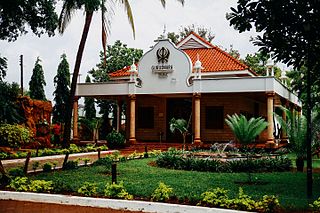| Part of a series on |
| Sikhism |
|---|
 |
This is a list of gurdwaras in Africa. A gurdwara is a place of worship in Sikhism. It is a place where Sikhs can gather to hear devotional hymns and recital from the Guru Granth Sahib - the Sikh holy book.
| Part of a series on |
| Sikhism |
|---|
 |
This is a list of gurdwaras in Africa. A gurdwara is a place of worship in Sikhism. It is a place where Sikhs can gather to hear devotional hymns and recital from the Guru Granth Sahib - the Sikh holy book.
The following outline is provides an overview of Sikhism, or Sikhi.

Kericho is the biggest town in Kericho County located in the highlands west of the Kenyan Rift Valley. Standing on the edge of the Mau Forest, Kericho has a warm and temperate climate making it an ideal location for agriculture and in particular, the large scale cultivation of tea.

Talwandi Sabo is a town and Municipal Council in Bathinda district, Punjab, India. It is world-famous for being one of the five Takhts of Sikhism, Takht Sri Damdama Sahib. It is famous for its Baisakhi, which is celebrated on 13 April and attracts lakhs of visitors, every year.

Dera Baba Nanak is a town and a Municipal council in Gurdaspur district in the state of Punjab, India. Recently in November 2019, a corridor between India and Pakistan has been established at its shrine.
Sikhism is a minority religion in Belgium, but Sikhs have played a role in Belgian history; during World War I, many Sikhs fought in Belgium. In the First Battle of Ypres, an entire platoon of Dogra Sikhs died.

Delhi Sikh Gurdwara Management Committee or DSGMC is an autonomous organisation which manages Gurudwaras in Delhi state. DSGMC also manages various educational institutions, hospitals, old age homes, libraries and other charitable institutions in Delhi. It is headquartered in Gurdwara Rakab Ganj Sahib, near Parliament House. In 1971, the Government of India entrusted the management, through an ordinance, to a five-member Gurdwara Board. The ordinance was replaced by the Delhi Sikh Gurdwaras Act, 1971, passed by Parliament, providing for a committee to be elected by Sikh vote. Elections took place under the supervision of government authority and the new body called Delhi Sikh Gurdwaras Management Committee (DSGMC) came into existence in 1974. Under the provisions of the Act, the elections must take place every four years.
German Sikhs are a religious minority in Germany. Many German Sikhs have their roots from the Punjab region in India. They number between 15,000 and 21,000. Germany had the third highest Sikh population in Europe after United Kingdom and Italy.
Sikhs are a religious minority in the Netherlands. They number around 12,000 and most of them live in or around Amsterdam. There are Seven gurudwaras in the Netherlands.
The permanent arrival of Sikhism in England is dated to 1850 A.D. with the arrival of Maharajah Duleep Singh. The first Sikh place of worship, called a Gurdwara, was opened in 1911 in London and this was partly funded by the Maharaja of Patiala.

Kiratpur also known as Kiratpur Sahib is a town in Rupnagar district, Punjab, India. The town is the location of the Gurdwara Patal Puri where Sikhs take ashes of their deceased.

Gurdwara Janam Asthan, also referred to as Gurdwara Nankana Sahib, is a highly revered gurdwara that was built at the site where the founder of Sikhism, Guru Nanak, was believed to be born. The shrine is located in the city of Nankana Sahib, near the city of Lahore in the Punjab province of Pakistan.

Sikh Temple Makindu is located about 104 miles (170km) from Nairobi on the main Nairobi to Mombasa Road. It was built in 1926 by the Sikhs who were working on the construction of the Uganda railway line from the coast (Mombasa) inland to Lake Victoria and beyond to Uganda. Today, all types of people visit this Gurdwara everyday and it is a 'must-see' Gurdwara for any Sikh travelling to Kenya and East Africa.

Hazur Sahib, also known as Takht Sachkhand Sri Hazur Abchalnagar Sahib, is one of the five takhts in Sikhism. It is located on the banks of the Godavari River at the city of Nanded in the state of Maharashtra, India. The gurdwara within the complex is known as Sach-Khand.

Nanakmatta is a historical town named after the Sikh pilgrimage site, Gurdwara Nanak Mata Sahib, in the state of Uttarakhand in India. Sikh tradition records that the site was once called Gorakhmata, a centre of Siddh-jogis named after the founder of their order, Gorakhnath, at the distance of 30 miles from Reetha sahib. In the Siddh-Gost in Guru Granth Sahib, the story of Guru Nanak on his first udasi is told, wherein he had a long discourse with siddhas on matters of religion and metaphysics. Tradition says that the place was renamed Nanakmatta to perpetuate the memory of Guru's visit. The town is associated with Guru Nanak Dev and Guru Hargobind. It is situated on the bank of Deoha stream, which has since been dammed into a reservoir named Nanak Sagar. The Gurudwara is located 15 kilometres west of Khatima Railway Station on road to Tanakpur. The holy shrine is near the town of Sitarganj. It is one of three Sikh Holy places in the state, with others being Gurdwara Hemkunt Sahib and Gurudwara Reetha Sahib.

Guru Nanak Jhira Sahib is a Sikh historical shrine situated in Bidar, Karnataka. Gurdwara Nanak Jhira Sahib was built in the year 1948 and is dedicated to the first Sikh guru Guru Nanak. Bidar has a very long association with Sikhism as this is the home town of Bhai Sahib Singh, one of the Panj Pyare, who offered to sacrifice their heads and were later baptised as the first members of the Khalsa.